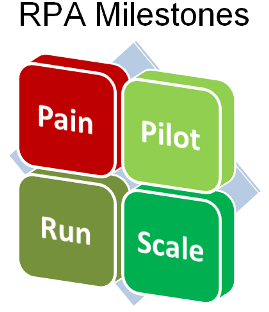Robotic Process Automation – Why and How Your Competitors are Ahead

It’s a pretty safe bet most people reading this post are reasonably familiar with what Robotic Process Automation (RPA) means and what the technology can do. It’s also likely their knowledge exceeds their company’s – which could be just turning its attention to robotic software. The question to ask is: where’s the competition? From our perspective, at least some are moving faster – maybe more. If so, what should be your company’s response? What best practices can be leveraged to expedite adoption and benefits from this technology?
Roadblocks to RPA Adoption
From UiPath’s perspective, even rapid growth can’t whitewash the question of why more companies aren’t rushing to embrace process automation. After all, automatons take over repetitive jobs no one particularly enjoys, work 24/7, can’t drift into mistakes, and scale up and down at a moment’s notice.
In fact, years of experience has taught us very real barriers to entry, factors that need to be recognized and confronted for any widespread introduction of robotic software to succeed, exist.
Operational Fog: process automation sounds easy – just look for repetitive, highly rules-based workflow activities and automate them. In reality, few managers are familiar enough with their employee’s workflows to know where to look. Process documentation? The person in charge of keeping that updated was let go ten months ago: maybe there’s a folder somewhere on the network drive.
Horrible Optics: there’s not a lot of general readership for any paper’s business section – unless robots are taking over the world. Even better, robots are taking over local jobs. Not many management teams aspire to this publicity.
Business Technophobia: robotic software is….software. It may not be complicated, but it’s not enough to train a business user – they then have to turn around and train the software to do their repetitive tasks. A manager needs to be open to understand what’s involved or it can sound….complicated.
IT “Hello & No” Department: RPA products have small IT footprints. They don’t integrate tightly with other applications or databases and won’t undermine any security policies. But they will need to run through the IT Department’s approval gauntlet, something most business managers are loath to contemplate, even on really good days.
Why Some Companies Succeed
All companies face these barriers to greater or lesser degrees, so what enables some to break through and implement the technology quicker and faster than others? More importantly, can other companies apply the success techniques UiPath has observed? To answer the last question first; yes, the successful tactics we’ve seen aren’t unique, just well planned and executed. For the first question, three traits distinguish first-movers from also-rans.
Creative Responses to Relentless Budget Pressure: beyond exceptions like Apple, few companies have profit margins large enough to shield budgets from relentless cost cutting. In many organizations, successive rounds of cuts have blunted imaginative

thinking and encouraged a reactive mentality (think Boxer in Animal Farm). Only a few companies hear the drumbeat of diminishing returns and stay risk-taking and creative to protect margins and performance metrics while reducing expenses.
Urgent Operational Pain: even a culture of risk-taking and creative budget-shaving isn’t typically willing to gamble real investments against conceptual technology rewards. Urgent and sharp operational pain is also required. As an example, confidential merger activity in early November requires a new book of insurance business to be migrated before the first of the year; or post-Christmas product issues suddenly begin swamping call center capacity.
A Motivated Champion: creative thinking and pain relief are critical drivers in technology adoption, but the absolutely indispensable ingredient for success is leadership. A stakeholder in the pain point, positioned with credibility and political capital in the company, has to have the vision, weigh the odds and take on the risk of change.
As a practical matter, these three elements generally converge rather than emerge simultaneously. The first element - creatively responding to constant cost pressures, allows decision-makers to become aware of and knowledgeable about RPA products over time – before urgent pain hits. When it does hit, a leader can turn informed decision-makers into a consensus for innovative change.
How Innovative Companies Transform Operations
This consensus for change is usually defined in scope by the urgent organizational pain that forged it and the stakeholder who leads it. Based on what we’ve seen at UiPath, there are common milestones in the transformational roadmap.
Pain: as noted, the initial transformational scope is dictated by the triggering organization pain point. Successful companies prioritize workflows within those areas and carefully select the most automation-compliant ones for the initial effort. Then, once workflows have been prioritized, a RPA vendor is picked using those workflow characteristics as a foundation for the evaluation criteria. The vendor

should demonstrate expertise in both the company’s industry and business operations. References should establish credibility for the company, the product, technology and capability for training and support.
Pilot: with scope established and vendor selected, leadership should plan, resource and budget an automation pilot. While many companies do not require formal IT review and approval of technology for pilot programs, this is the right point to involve their expertise. Most importantly, a criteria for success should be established and endorsed by business users, IT and business unit management. The measurement of success should go beyond workflow performance metrics and include vendor support, product functionality and end user satisfaction.
Scale: regardless of success or failure, the pilot should be closed out with lessons learned. In the case of a successful pilot, lessons learned are used to effectively scale up to full automation of activities within the organizational pain point. The objective of scaling up is to replicate, and run parallel with, existing manual workflows. The goal of scaling up is to: validate pilot performance and cost benefits; verify vendor and product functionality and capabilities; determine the flexibility, responsiveness, reporting and analytics of the automaton platform. The versatility and usefulness of the automation platform is a critical evaluation point. While desktop automatons may be sufficient for small pilots, full scale automation typically requires a server or cloud-based platform from which cloned automatons are activated/deactivated and dashboard monitoring of all automaton metrics.
Run: a successful pilot and scaled performance completes the ‘build’ stage of automation transformation and leads to the ‘run’ stage. The objective of the run stage is the capability to effectively automate qualified workflows throughout the company.
The ‘run’ goal is to establish practical governance methodology for: process change management; business workflow qualification and prioritization; resource training and vendor management; IT, business continuity and infrastructure planning; automation resourcing, reporting and management.
One word hasn’t been used in this elucidation of our experiences with innovative clients – strategic. In fact, everything mentioned has been strictly tactical in nature. Would a strategic approach to process automation be more advantageous? Yes. A strategic plan is more likely to use resources more efficiently and reap more benefits over time than tactical actions. However, a funded strategic plan for robotic process automation is so seldom seen that holding it up as an aspiration standard would simply be misleading. We look forward to future clients changing our minds.

Strategic Advisor, Tquila Automation
Get articles from automation experts in your inbox
SubscribeGet articles from automation experts in your inbox
Sign up today and we'll email you the newest articles every week.
Thank you for subscribing!
Thank you for subscribing! Each week, we'll send the best automation blog posts straight to your inbox.



